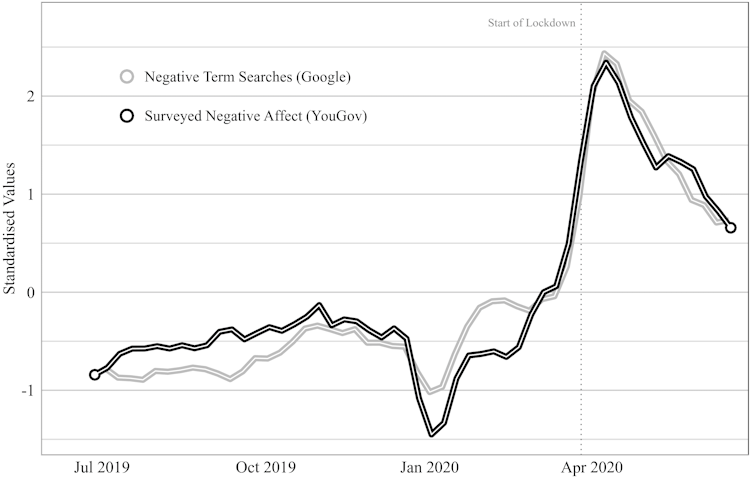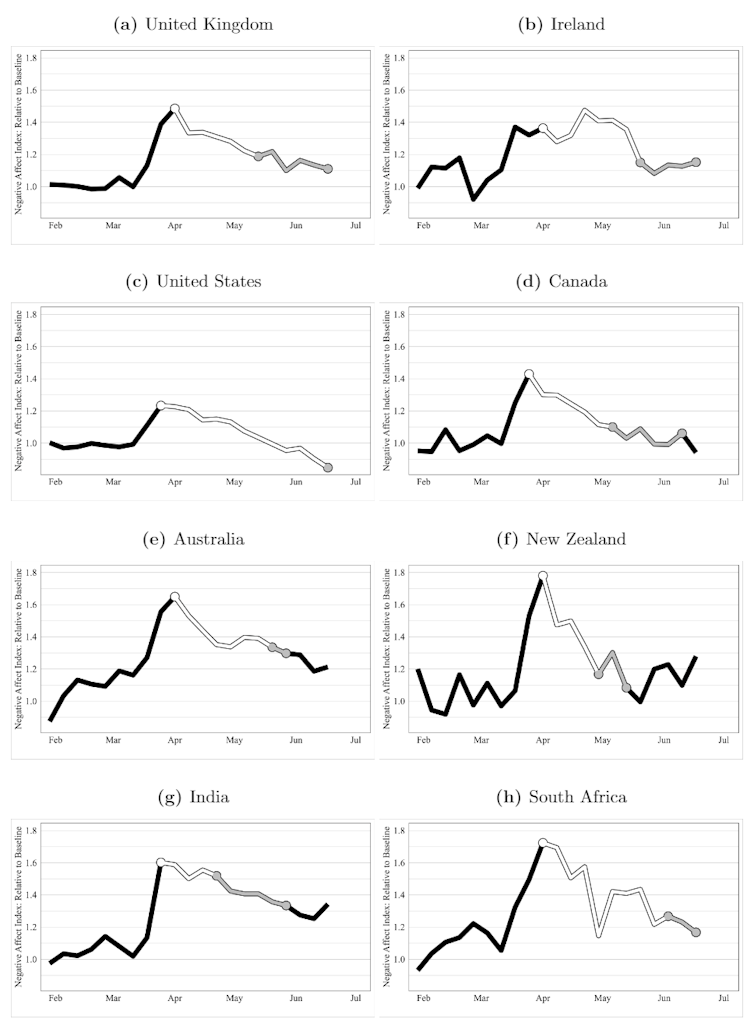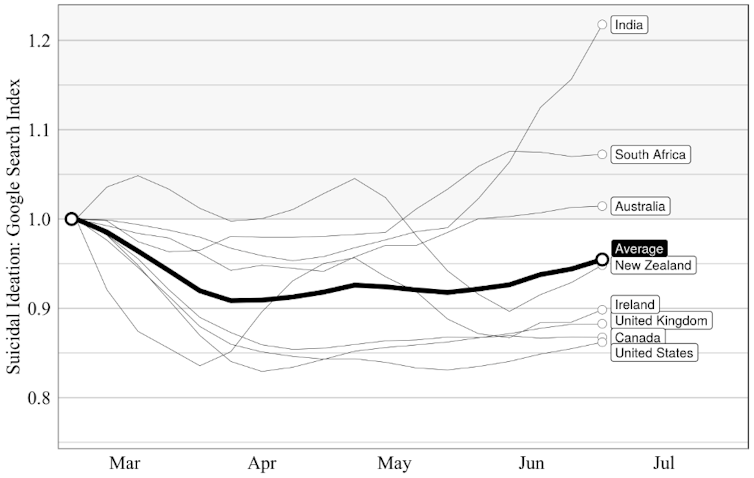Lockdowns are seemingly vital for controlling COVID-19. Early evidence suggests they have a big effect on preventing deaths. But if we’re to keep using them, we also need to know their broader impacts. Many people are worried about lockdowns also having a negative effect on mental health.
Indeed, most assessments have found that they do. But these studies usually can’t distinguish between the effects of the pandemic and of lockdowns specifically. This is because they often only compare people’s mental states from before the pandemic and after lockdowns were introduced. A decline in wellbeing might be a response to the overall pandemic.
To better judge the impact of lockdowns on wellbeing, we need to isolate the critical period after the pandemic started but before lockdowns were launched, and compare how people felt at this point with how they felt during lockdown.
So, we conducted a study using data from YouGov’s UK weekly mood tracker and Google Trends to do this. Following a rise in negative emotions at the start of the pandemic, we found that wellbeing improved once lockdowns began – though not consistently for all social groups.
Separating lockdowns from the pandemic
From June 2019 to June 2020, YouGov surveyed a nationally representative sample of around 2,000 respondents each week across Great Britain. It asked them to report on 12 mood states: happiness, contentment, inspiration, optimism, energy levels, sadness, apathy, stress, boredom, frustration, loneliness and fear.
Data from the survey suggests that the pandemic had a strong negative effect on people’s mood, but that this quickly returned to baseline after the introduction of lockdown. Boredom, loneliness, frustration and apathy increased with the introduction of lockdown, but so did happiness, optimism, contentment and even inspiration. Meanwhile, sadness, fear and stress all fell.
Unfortunately, overall life satisfaction questions were only introduced into the mood tracker in April 2020. So, to consider how the pandemic and lockdown affected people’s general wellbeing, we had to attribute scores to respondents for the period prior to April based on their mood data (we calculated the scores using a statistical technique called regression).
While far from ideal, the results from this analysis – depicted in the figure below – suggest that life satisfaction similarly fell with the arrival of the pandemic and rebounded after lockdown began.

Life satisfaction in Great Britain between June 2019 and June 2020. Author provided
Lockdowns, while demanding, are a decisive and effective government response. So it’s perhaps not surprising that, with the threat of COVID-19 having rapidly accelerated in March, their introduction would to some extent lessen people’s concerns.
Using Google to compare countries
We then turned to Google search data in order to look at other countries. We wanted to see how people’s feelings of negative emotions – what’s known as “negative affect” – may have changed over time.
Google Trends shows the relative popularity of specific Google search terms on a week-by-week basis. We focused on the period June 2019 to June 2020, restricting our analysis to English-speaking countries – namely the UK, New Zealand, Australia, India, South Africa, Ireland, the USA and Canada.
We then created a measure of negative affect by looking at the combined popularity of the following terms: “psychological stress”, “boredom”, “frustration”, “sadness”, “fear” and “apathy”.
As shown in the following figure, the trend of negative affect seen in UK Google searches closely matches the trend seen in the YouGov mood survey.

The trends of negative affect in the YouGov survey data and UK Google search data, standardised for comparison (mean=0, standard deviation=1). Author provided
And the Google data shows similar trends across other English-speaking nations. This measure of negative affect rose sharply with the outbreak of the pandemic, then began to fall as lockdowns were implemented.

Changes in negative affect by country, relative to a pre-pandemic baseline period (January 15 to February 15), according to their Google search data. Full lockdown indicated by white lines; partial lockdown indicated by grey lines. Author provided
Statistical analysis of these trends in the Google data shows that, on average, negative affect fell by 17% in the one-month period immediately after various lockdowns were introduced. Again, given that lockdowns tended to begin when uncertainty, new COVID-19 cases and daily deaths were at their peak, it’s perhaps not surprising that we see this effect.
Some social groups were affected more than others
Finally, we also used the YouGov data to look at how the pandemic and lockdown affected the wellbeing of different groups of people in Great Britain. We found that about half of the total effect of the pandemic and lockdown is sociotropic, meaning that it affected everyone similarly.
Of the remaining half, we found acute negative effects on the wellbeing of the elderly, professionals, those living alone and women.
The wellbeing of elderly people had already fallen prior to lockdown beginning, most likely because of the greater threat posed to older age groups by COVID-19. Increases in social isolation, loneliness and boredom post lockdown may then have disproportionately affected older groups, as well as people living alone.
For small business owners and staff, economic insecurities related to retail closures and employee furloughs may have had a disproportionate impact on wellbeing.
And it’s clear that lockdown entailed particular hardship for women, often because of additional childcare and home schooling responsibilities not being shared equally.
But we also found positive effects for low socioeconomic status (SES) individuals, especially men. We suspect that this reflects the income support made available to these individuals. The following figure shows how life satisfaction rose among three low SES groups (skilled and unskilled manual labourers and the underemployed) during the lockdown according to the YouGov data.

Changes in life satisfaction for three low SES groups in Great Britain: skilled manual labourers, unskilled manual labourers and the underemployed (those of working age not studying or in full-time employment). White portions of lines indicate a statistically significant difference since March 5, the date of the first diagnosed COVID-19 fatality in Great Britain. Author provided
Low SES men are one of the highest risk groups for completed suicide attempts. The relatively good mental health outcomes for this group during lockdown could provide one explanation for the somewhat unexpected reduction in suicides that has been seen in some countries during the pandemic.
Search data also highlights a potential link between income support and suicide rates. The figure below shows international search trends for suicidal ideation over the pandemic-lockdown period. India and South Africa, two countries that implemented lockdowns with minimal social support mechanisms, are clear outliers, with sharply rising rates of suicidal ideation.

Search trends for suicidal ideation by country, compared to mid-February baseline. Author provided
Much of the world is reopening, but further lockdowns may be necessary in the event of a second viral wave. While there are many factors to consider when deciding whether to lock down, the impact on mental health isn’t straightforward. Our research suggests that while lockdowns do adversely affect some groups, they also have the potential to redress some of the negative mental health impacts of the pandemic itself.
 Mark Fabian, Roberto Foa and Sam Gilbert do not work for, consult, own shares in or receive funding from any company or organisation that would benefit from this article, and have disclosed no relevant affiliations beyond their academic appointment.
Mark Fabian, Roberto Foa and Sam Gilbert do not work for, consult, own shares in or receive funding from any company or organisation that would benefit from this article, and have disclosed no relevant affiliations beyond their academic appointment.
The YouGov-Cambridge Centre for Public Opinion Research is a collaborative initiative between YouGov and the Cambridge Department for Politics and International Studies. None of the authors receive financial compensation for their participation in this initiative.



 Wikipedia Pushes for AI Licensing Deals as Jimmy Wales Calls for Fair Compensation
Wikipedia Pushes for AI Licensing Deals as Jimmy Wales Calls for Fair Compensation  Anthropic Reportedly Taps Wilson Sonsini as It Prepares for a Potential 2026 IPO
Anthropic Reportedly Taps Wilson Sonsini as It Prepares for a Potential 2026 IPO  Norway’s Wealth Fund Backs Shareholder Push for Microsoft Human-Rights Risk Report
Norway’s Wealth Fund Backs Shareholder Push for Microsoft Human-Rights Risk Report  Firelight Launches as First XRP Staking Platform on Flare, Introduces DeFi Cover Feature
Firelight Launches as First XRP Staking Platform on Flare, Introduces DeFi Cover Feature  Apple Leads Singles’ Day Smartphone Sales as iPhone 17 Demand Surges
Apple Leads Singles’ Day Smartphone Sales as iPhone 17 Demand Surges  TSMC Accuses Former Executive of Leaking Trade Secrets as Taiwan Prosecutors Launch Investigation
TSMC Accuses Former Executive of Leaking Trade Secrets as Taiwan Prosecutors Launch Investigation  YouTube Agrees to Follow Australia’s New Under-16 Social Media Ban
YouTube Agrees to Follow Australia’s New Under-16 Social Media Ban  Morgan Stanley Boosts Nvidia and Broadcom Targets as AI Demand Surges
Morgan Stanley Boosts Nvidia and Broadcom Targets as AI Demand Surges  Taiwan Opposition Criticizes Plan to Block Chinese App Rednote Over Security Concerns
Taiwan Opposition Criticizes Plan to Block Chinese App Rednote Over Security Concerns  AI-Guided Drones Transform Ukraine’s Battlefield Strategy
AI-Guided Drones Transform Ukraine’s Battlefield Strategy  ByteDance Unveils New AI Voice Assistant for ZTE Smartphones
ByteDance Unveils New AI Voice Assistant for ZTE Smartphones  Hikvision Challenges FCC Rule Tightening Restrictions on Chinese Telecom Equipment
Hikvision Challenges FCC Rule Tightening Restrictions on Chinese Telecom Equipment  Intel Boosts Malaysia Operations with Additional RM860 Million Investment
Intel Boosts Malaysia Operations with Additional RM860 Million Investment  Microchip Technology Boosts Q3 Outlook on Strong Bookings Momentum
Microchip Technology Boosts Q3 Outlook on Strong Bookings Momentum  Trump Administration to Secure Equity Stake in Pat Gelsinger’s XLight Startup
Trump Administration to Secure Equity Stake in Pat Gelsinger’s XLight Startup  Banks Consider $38 Billion Funding Boost for Oracle, Vantage, and OpenAI Expansion
Banks Consider $38 Billion Funding Boost for Oracle, Vantage, and OpenAI Expansion 

































